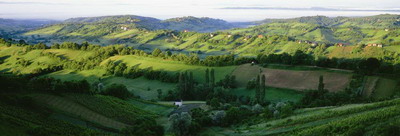CROATIA - NATURE PARK ZUMBERAK
the hill close to slovenian border
Croatia - Nature Park Zumberak, very close to Karlovac and Zagreb

ZUMBERAK, a hilly region (around 300 sq km) in southern Prigorje (lower slopes) of the Zumberak range. Named after the old burg of Zumberak (burnt down in 1793; ruins above the village of the same name). Typical karst relief (sinkholes, caves, abysses, underground streams) with forests of beech and chestnut. Chief occupations are farming, viticulture and livestock breeding. Villages of a scattered type with compact hamlets, the largest being those along the main roads (Budinja, Stojdraga, Gornja Vas, Ostrc, Sosice, etc.). The majority of the settlements lie above 400 m. The region used to be inhabited in the pre-historic (Budinjak, a habitation and necropolis from the Early Iron Age, Kalje) and Roman per-iod (Gornja Vas). Since the settlement of the Croats in these regions Zumberak and Bela Krajina (7th-13th c.) were a part of Croatia, under the jurisdiction of the newly established diocese in Zagreb (1094). Under the reign of Andrew II (1204-1235) Zumberak was dependent on Metlika and Crnomelj and included in the Carniolan March. At the beginning of the 14th century the religious administration was subjected to the Aquileian Patriarchate, i.e. Gorica (Gorizia) archdeaconry, which brought about a long-lasting conflict between the Zagreb diocese and the Aquileian Patriarchate; only in 1784 was a part of Zumberak included in the Zagreb diocese. In the second half of the 15th century the Ottoman Turks devastated the area of the Zumberak range. Thus Zumberak became almost completely deserted already at the beginning of the 16th century. The Habsburg rulers decided to populate their desolate estates with groups of Uskoks (Croatian rebels against the Ottoman rule - the first groups settled in 1530), who were Catholic and Orthodox; the latter became Uniates at the beginning of the 17th century. The Zumberak Captaincy was annexed in 1578 to the Slunj Captaincy and thus became included in Vojna Krajina (Military Border District). Upon reunification with Civil Croatia in 1881, Zumberak became a district of the Zagreb County, and the seat of the district was in Kostanjevac. During the Baroque period some of the older churches were reconstructed so that -only few preserved features of previous periods, such as the churches in Kalje and Zumberak which still have some Gothic elements. Members of the Uniate Church are found as a community only in Zumberak. The oldest Uniate parish of St. Nicholas was founded in Badovinci in 1620. The chapels in Sosice, Kast and Radatovic were part of it. The church of Sts. Peter and Paul in Sosice was erected in 1756.
The Zumberak range (in Slovenian Gorjanci) is a borderland between Croatia and Slovenia, with special tourist importance, primarily of mountain type, for the both countries. A smaller portion of the range - Samoborsko Gorje (Japetic, the highest top, attains 880 m) - is often separately presented and has been visited for more than a hundred years by many excursionists and hikers. Many marked trails and paths, such as Karlovac Hiking Transverse, the beautiful countryside (Sopote Waterfalls, 60 m, on the Kupcina river, the Slapnica brook, Eco-village Kravljak, Bio-park Gabrovica), villages and old hill-forts represent chief attractions in this hiking and tourist region. Climbing the highest top, Sveta Gera (1,178 m) has a multiple symbolic meaning. There are several small, indigenous villages attractive for tourists (the whole region of Zumberak is an ethno-village). The hamlets of Sosice, Ostrc, Tomasevci, Kalje, Stojdraga and other on the Croatian side as well as many on the Slovenian side are connected by roads with bigger centres - Samobor, Bregana, Jastrebarsko, Ozalj, etc.
The ruins of old feudal castles not far from the village Stari Grad (Kekici) and the hill-fort near Tomasevci bear evidence of a rarely found, long continuation of settlement in the region of Zumberak. Some of the sacral objects (primarily churches) of Catholic and Uniate religions are interesting due to their beauty and specific features.
Mountain climbing, hiking, hunting and angling represent chief sports and recreational activities in Zumberacko Gorje. The region offers traditional domestic cuisine, venison and fish specialities as well as the Plesivicko wine.
+385 1 3327 660
Web: www.ppzsg.org
The Zumberak range (in Slovenian Gorjanci) is a borderland between Croatia and Slovenia, with special tourist importance, primarily of mountain type, for the both countries. A smaller portion of the range - Samoborsko Gorje (Japetic, the highest top, attains 880 m) - is often separately presented and has been visited for more than a hundred years by many excursionists and hikers. Many marked trails and paths, such as Karlovac Hiking Transverse, the beautiful countryside (Sopote Waterfalls, 60 m, on the Kupcina river, the Slapnica brook, Eco-village Kravljak, Bio-park Gabrovica), villages and old hill-forts represent chief attractions in this hiking and tourist region. Climbing the highest top, Sveta Gera (1,178 m) has a multiple symbolic meaning. There are several small, indigenous villages attractive for tourists (the whole region of Zumberak is an ethno-village). The hamlets of Sosice, Ostrc, Tomasevci, Kalje, Stojdraga and other on the Croatian side as well as many on the Slovenian side are connected by roads with bigger centres - Samobor, Bregana, Jastrebarsko, Ozalj, etc.
The ruins of old feudal castles not far from the village Stari Grad (Kekici) and the hill-fort near Tomasevci bear evidence of a rarely found, long continuation of settlement in the region of Zumberak. Some of the sacral objects (primarily churches) of Catholic and Uniate religions are interesting due to their beauty and specific features.
Mountain climbing, hiking, hunting and angling represent chief sports and recreational activities in Zumberacko Gorje. The region offers traditional domestic cuisine, venison and fish specialities as well as the Plesivicko wine.
Web: www.ppzsg.org




 0038523394636
0038523394636



